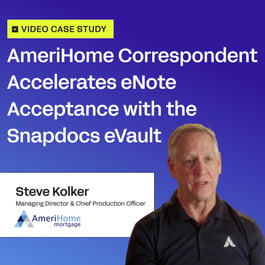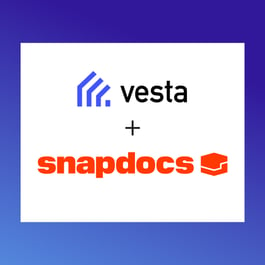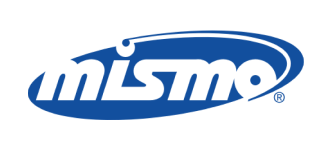CASE STUDY
The Federal Savings Bank & BCHH Improve Lender-Settlement Coordination with Connected Closings
As pioneers in the mortgage industry, The Federal Savings Bank and BCHH Title adopted Connected Closings with the collective goal of improving borrower experience and upleveling their entire eClose strategy.

Key results
1.5
Faster time to close by at least 1.5 days
100%
Visibility into closing appointment details
2X
Faster return rate for scanbacks
90%
of borrowers eSign prior to appointment (leading to 15-minute or less hybrid signing appointments)
Driving settlement adoption is a critical component of scaling digital closings. However, fragmentation between lender and settlement workflows makes digital closing adoption difficult for many lenders and their settlement partners.
To solve this challenge, Snapdocs created Connected Closings, a first-of-its-kind integration between the Snapdocs eClosing and Notary Scheduling platforms.
Connected Closings: the next step in digital closings at scale
Prior to working with Snapdocs, The Federal Savings Bank had implemented a different eClosing platform. When Desiree Kirkland joined The Federal Savings Bank as SVP of Closing Operations in early 2021 she noticed a lag in overall adoption. “The platform [we had at the time] wasn’t very user-friendly, so it wasn’t being used. We weren’t really doing a lot of hybrids or eClosings as a whole,” Kirkland said.
With Kirkland at the helm, the company switched to the Snapdocs eClosing platform, immediately noting an increase in hybrid closings from 23% to about 87%, thanks to the hand-in-hand implementation and rollout support from the Snapdocs team. Kirkland shared that hybrid adoption is on track to grow to 90-95%, once the company closes all loan programs as hybrid. When Snapdocs announced its Connected Closings integration, The Federal Savings Bank saw it as an opportunity to drive continued eClose adoption, as well as streamline workflows with their title partner, BCHH.
“One of the benefits I love about Connected Closings is that we now have the ability to communicate with the notary and title company all in one platform. We get real-time updates on the status of the signing appointment so we never have to wonder whether the closing is happening as planned,” shared Kirkland.
“Plus, the borrower has visibility of the notary to see a picture of the person that's meeting them. I think that provides some more comfort to the borrower, especially in this day and age where we're careful of who to let into our home or business.”
Kirkland shared that Connected Closings has enabled immediate document transfers with BCHH, which has proved invaluable for rush jobs, especially when document accuracy is critical for same-day closings. “We’re able to make adjustments on the fly and keep moving forward,” she said, adding that this capability improves their reputation as a great lender for borrowers and settlement companies alike. “The reduction in scanback time has been instrumental in us funding faster. And our increased hybrid adoption has reduced errors tenfold because the majority of the package is being eSigned, and we don’t have the typical signing issues we see with non-digital closings like illegibility and missing information.”
Melanie Miller, Senior Operations Manager at BCHH, echoed the value that the integration between the Snapdocs Notary Scheduling and eClosing platforms deliver to her business. In her role at BCHH, Miller’s team uses the Snapdocs Notary Scheduling platform to automatically assign quality notaries for closings in all 50 states.
“Our organization’s journey with Snapdocs has been transformative. When we first started using Snapdocs, it completely revolutionized how we scheduled and managed our closing appointments,” Miller said. “The platform provides seamless and efficient solutions to connect with the notary, the lender, and the borrower—all reducing the time and effort involved in the process. The platform successfully built a vast and diverse network of notaries across the various regions, and the wide reach ensures that we can find the right notary for the right closing at the right time, regardless of where it takes place.”
Miller shared that Connected Closings has been a game-changer in eliminating the manual tasks and errors for her team. Miller further noted that the ability to send automated signing updates ensures that the lender, scheduler, and notary are always in-sync, helping BCHH stand out to lenders. “Utilizing Snapdocs has contributed to a smoother and more streamlined closing process, which ultimately enhanced the customer experience.”
Knowing BCHH’s commitment to providing a tech-driven, top-notch experience for every customer, The Federal Savings Bank asked BCHH to be among their first partners to use Connected Closings and plans to expand its use to their other settlement partners in the near future.
Results
With Connected Closings, The Federal Savings Bank and BCHH have said goodbye to the many industry-wide challenges that have led to the complicated, error-prone closings of the past.
Kirkland describes why Connected Closings is so impactful as a lender saying, “Being able to communicate directly with (the notary) has been instrumental in reducing a lot of our errors. The ability to transfer documents in real-time is also significantly impactful in reducing errors on the backend, and at signing, to save time.”
Miller agreed, adding her perspective from the settlement side. “Connected Closings takes the stress out of scheduling a notary. It allows the focus to be put back on the customer by keeping everybody connected in real-time,” she said. “We can now easily communicate with notaries, share important documents, track the progress—all within the platform.”
Additional eClosing resources

Trust and Security in Digital Closings

Plains Commerce Bank Cuts Funding-to-Sale Time by 7 Days ...

Transforming the Mortgage Lifecycle with AI: Solutions in ...

AI in Mortgage Operations: Strategic Approaches for ...

Smarter, Faster, Leaner: How AI is Reshaping Mortgage ...

AmeriHome Correspondent Accelerates eNote Acceptance with ...

Snapdocs Partners with Vesta to Offer an Integrated ...






